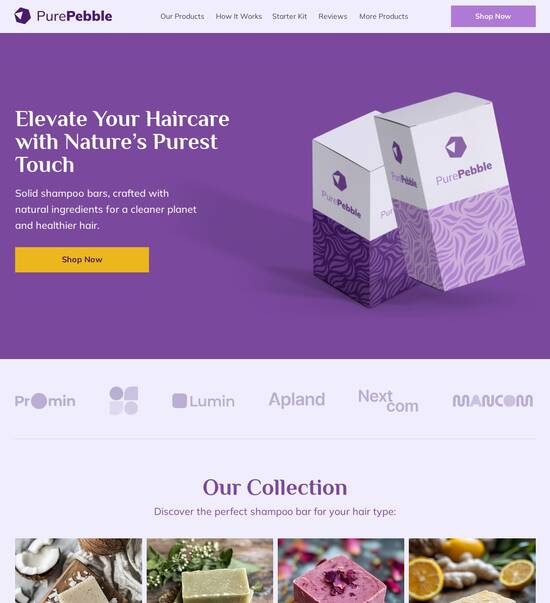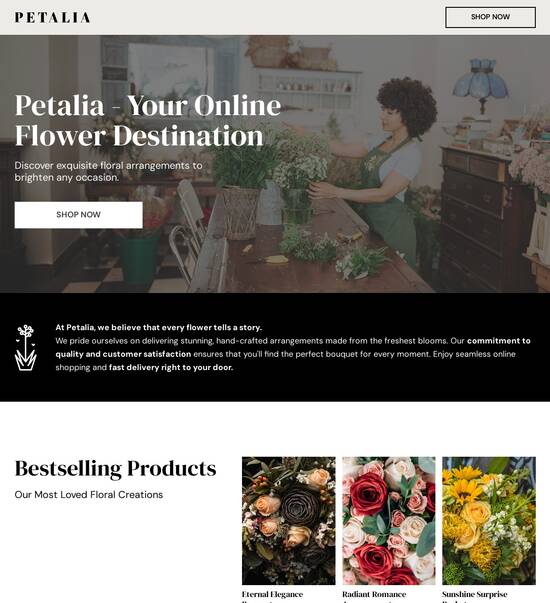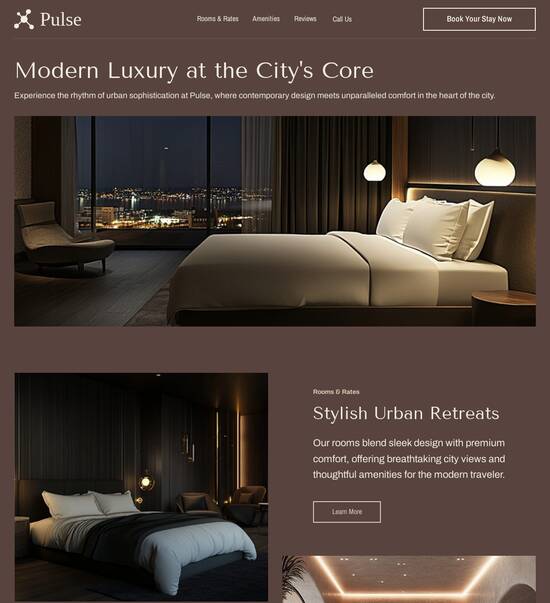
Material design 404 error page template
Explore Similar TemplatesAbout template
Unleash your creativity with the material design 404 error page template. Try Instapage today.
Recommended templates

Easy to build without coding
With the intuitive drag-and-drop builder, anyone on your team can create high-converting pages without any knowledge of code or design. Make enhancements to your landing page with custom widgets using Javascript, HTML/CSS, or third-party scripts.

Multiple layouts for any industry and goal
Select from 500+ landing page layouts built to boost conversions across industry-specific scenarios. Customize them by adjusting fonts, adding images, and generating on-brand content with the AI assistant. Quickly scale with Instablocks® and Global Blocks that you can save, reuse, and update globally.

Loads fast and looks polished on any device
Every template is responsive, which means they present professionally on any device and load blazingly fast with our Thor Render Engine. You can also power them up with Google AMP technology to deliver an unparalleled mobile experience and drive higher conversions.

Robust analytics & experimentation
Get real-time updates and reporting across all your devices, showing the number of visitors, conversions, cost-per-visitor, and cost-per-lead. Launch AI-powered experiments, run A/B tests, and use heatmaps to analyze user behavior, then optimize your landing page to maximize conversions.







Easy to build without coding
With the intuitive drag-and-drop builder, anyone on your team can create high-converting pages without any knowledge of code or design. Make enhancements to your landing page with custom widgets using Javascript, HTML/CSS, or third-party scripts.
Multiple layouts for any industry and goal
Select from 500+ landing page layouts built to boost conversions across industry-specific scenarios. Customize them by adjusting fonts, adding images, and generating on-brand content with the AI assistant. Quickly scale with Instablocks® and Global Blocks that you can save, reuse, and update globally.
Loads fast and looks polished on any device
Every template is responsive, which means they present professionally on any device and load blazingly fast with our Thor Render Engine.
Robust analytics & experimentation
Get real-time updates and reporting across all your devices, showing the number of visitors, conversions, cost-per-visitor, and cost-per-lead. Launch AI-powered experiments, run A/B tests, and use heatmaps to analyze user behavior, then optimize your landing page to maximize conversions.
All the features you need to build lead-generating landing pages
Explore more featuresLearn how to build top-performing landing pages for any goal
FAQs
Leading the way in building high-performing landing pages





An effective guide to mastering Instapage for landing page optimization
In the ever-evolving landscape of digital marketing, creating high-converting landing pages is crucial for maximizing ROI on your campaigns. Instapage is a powerful platform that enables marketers to build, optimize, and personalize landing pages efficiently. This step-by-step guide will help you navigate through the features of Instapage to enhance your marketing strategies.
Understanding the core features of Instapage
Instapage provides a comprehensive suite of tools designed to elevate your landing pages. Its intuitive interface and robust functionalities cater to marketers across various industries, ensuring that you can adapt and succeed regardless of your budget or team size. Let's explore the primary features that make Instapage the go-to solution for landing page creation.
- High-converting templates: Choose from 100+ pre-built templates tailored for various industries to kickstart your campaigns.
- A/B testing capabilities: Optimize your landing pages through experiments that help you understand what resonates with your audience.
- Collaboration tools: Facilitate teamwork with instant feedback mechanisms and real-time edits, streamlining the production process.
Step 1: Building your first landing page
Creating a landing page on Instapage is a straightforward process. Follow these steps to ensure your page effectively captures leads and drives conversions.
- Select a template: Browse through the extensive library of templates available and choose one that fits your campaign's theme.
- Customize your design: Use the drag-and-drop builder to modify elements, add your branding, and align your message with your target audience.
- Configure lead generation elements: Implement forms and call-to-action buttons strategically for optimal lead capture.
Step 2: Optimizing for higher conversions
After building your landing page, optimization is key to maximizing conversions. Here's how Instapage can assist you.
- Utilize heatmaps: Analyze user interactions on your page to identify areas for improvement.
- Conduct A/B tests: Experiment with different headlines, images, and calls to action to see what yields the best results.
- Review analytics: Leverage the analytics dashboard to monitor traffic, conversion rates, and user behavior.
Step 3: Personalizing user experiences
Personalizing content can significantly boost engagement and conversions. With Instapage, tailoring experiences for your audience is seamless.
- Dynamic text replacement: Customize messaging based on the source of traffic to increase relevance.
- AdMaps functionality: Connect specific ads to dedicated landing pages, enhancing user journey continuity.
- Metric tracking: Analyze performance data at the audience level to iterate your approach.
Leveraging Instapage effectively leads to improved lead generation and higher ROI for your campaigns.
Ready to transform your landing pages? Start your journey with Instapage today and discover how it can elevate your marketing strategies.
People also ask about Material design 404 error page template
Material design 404 error page template: A comprehensive guide
Defining material design in web development
Material design is a design language created by Google that offers a set of principles and guidelines for crafting user interfaces across web and mobile applications. This approach emphasizes a tactile, physical metaphor where elements resemble their real-world counterparts. By leveraging materials like paper and ink in digital formats, material design provides a fresh perspective to user experience and engagement.
The principles of material design include depth and shadow, which create a sense of hierarchy and spatial relationships among elements. Bold colors and striking typography elevate visual engagement, enabling designers to captivate users at first glance. Furthermore, material design promotes responsive and adaptive layouts, ensuring seamless experiences across devices and screen sizes.
Depth and Shadow: Creating visual hierarchy with shadows that mimic physicality.
Bold Colors and Typography: Utilizing vivid hues and typography for user appeal.
Responsive and Adaptive Layouts: Ensuring the design adjusts fluidly across devices.
The importance of material design in enhancing user experience cannot be overstated. By focusing on clarity and usability, it fosters better interaction patterns, making it simple for users to navigate and accomplish their goals. Additionally, promoting consistency across platforms alleviates confusion and builds a cohesive brand experience.
Understanding the 404 error page
A 404 error page signifies that a user has attempted to access a URL that does not exist or cannot be found. This can occur for several reasons including broken links, mistyped URLs, or deleted pages. The principal purpose of a 404 error page is to inform the user of this error while giving them options to continue navigating the website rather than leaving frustrated or confused.
The impact of 404 errors on website performance can be significant. Users encountering a 404 error may abandon their session, thereby increasing bounce rates and leaving a negative impression of the site. Moreover, unmanaged error pages can have detrimental effects on search engine optimization (SEO), as search engines may penalize websites for excessive broken links or non-functioning pages.
Definition and Purpose: Inform users that a requested page is not found.
Common Causes: Issues like broken links, incorrect URLs, or removed content.
The role of a well-designed 404 error page
Crafting a user-friendly 404 error page is critical, as first impressions matter. When users encounter an error, the messaging should be clear and comforting. A well-informed message can help alleviate confusion by explaining the error succinctly. Furthermore, providing navigation options, such as links back to the home page or other relevant sections, can guide users on their journey through your website.
Error pages should also employ various strategies to reduce user anxiety. Visual elements such as humor or visuals can aid in creating a friendly and relaxed atmosphere. By transforming a potentially negative experience into an engaging interaction, users are more likely to continue exploring your site instead of leaving.
Clear Messaging and Navigation: Ensure users understand the error and how to proceed.
Strategies for Reducing Anxiety: Use visuals and tone to create a friendly atmosphere.
Key features of material design 404 error page templates
A material design 404 error page template should prioritize visual appeal and cohesion with the overall site design. Integrating bold colors and high-quality imagery helps maintain the visual integrity of the website while creating an aesthetically pleasing error page. The use of depth effects can further enhance this design by providing a layered look that evokes the principles of material design.
Moreover, an optimized layout for various screen sizes is essential. Responsive design principles ensure that the page looks good on devices of all sizes, from desktops to tablets and smartphones. A mobile-first approach not only guarantees better performance on handheld devices but also improves overall user experience.
Integrating Bold Colors and Imagery: Align with your branding while being visually appealing.
Utilizing Depth Effects: Provide a layered look that captivates users.
Responsive Design Principles: Make sure the error page is mobile-friendly.
Comprehensive content integration is also vital. Informative messaging that explains the error is essential, supplemented by functional elements like a search bar. This search feature allows users to find what they’re looking for without leaving the page. Additionally, including actionable links directing users back to the home page or key sections can further enhance navigation.
Elements of effective material design 404 error templates
Engaging graphics play a crucial role in capturing a user's attention on a 404 error page. Complimentary photography can significantly enhance visual appeal, helping to offset the user's frustration. Illustrations and icons should resonate with the overall theme of material design while effectively communicating the message, either through abstraction or humor.
Clarity in communication is equally important. Error messages should be succinct yet informative, establishing an immediate understanding of the issue. Pairing these messages with user-friendly language will guide users without adding to their confusion. Ensuring that the message is clear and relatable can foster a sense of understanding even amid errors.
Role of Photography: Use high-quality images to maintain visual integrity.
Crafting Clear Error Messages: Immediately inform and reassure users.
Action Buttons: Strategically placed for easy navigation.
Technical considerations for implementing material design error pages
For a seamless integration process, utilizing website templates tailored for material design can significantly enhance efficiency. Pre-built templates are particularly advantageous because they allow for a quick setup without compromising aesthetics or functionality. Options for customization also ensure that the template aligns with personal branding elements, fostering a cohesive site experience.
Additionally, plugin solutions can greatly enhance the functionality of error pages. Several key plugins are available that can help integrate search bars, social media links, or analytics features directly onto the error page. This enables site owners to monitor user behavior, understand exit paths, and refine their overall digital strategy.
Advantage of Pre-Built Templates: Speed up implementation without sacrificing quality.
Customization Options: Tailor templates to fit unique branding.
Key Plugins to Consider: Enhance functionality through integrations.
Real-world applications of material design 404 error page templates
Successful implementations of material design 404 error pages can be observed across various industries. For instance, tech companies often utilize engaging animations or graphics to lighten the mood, while e-commerce sites may provide direct links to popular product categories or featured items. These engaging elements can effectively retain users while offering alternatives to frustrating situations.
Analyzing user responses to unique 404 error designs reveals important insights. Metrics such as bounce rates before and after redesigns often showcase improvements in user retention and engagement. Conversely, lessons learned from failed attempts serve as a stark reminder of what not to do: overly complex messaging or cluttered visuals can exacerbate user frustration.
Distinctive Examples from Various Industries: Highlight unique implementations.
What Not to Do: Identify common pitfalls leading to poor user experiences.
Future trends in error page designs
Emerging techniques in user engagement promise to redefine 404 error pages. Innovative interactive elements are already in use, such as playable mini-games or polls, which can keep users entertained while addressing the error. Furthermore, the integration of artificial intelligence for personalized user experiences opens new avenues for error page design, creating tailored messages based on user profiles and browsing behavior.
Predictions for the evolution of material design suggest a continued rise in its application for error management. The principles of material design are likely to expand, driven by user feedback and evolving user expectations. As designers and businesses prioritize user-centric development, the design of error pages will likely adopt a more strategic approach, ultimately aiming for greater user satisfaction.
Innovative Interactive Elements: Engage users beyond standard messaging.
The Role of User Feedback: Shape future designs based on preferences.
Conclusion and summary of best practices
In summary, crafting an engaging 404 error page aligned with material design principles involves several essential components. Prioritize clear messaging, inviting visuals, and optimized navigation elements to ensure users can easily redirect themselves within your site. By fostering a culture of design thinking and focusing on user-centric development, businesses can significantly enhance the effectiveness of their error pages.
Recap Essential Components: Focus on visual style and user clarity.
Encourage User-Centric Development: A commitment to understanding and serving user needs.
Ready to skyrocket conversions?
Supercharge your ad campaigns with high-performing landing pages
Get started














